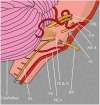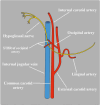Hypoglossal Nerve Neuropathies-Analysis of Causes and Anatomical Background
- PMID: 38672218
- PMCID: PMC11048189
- DOI: 10.3390/biomedicines12040864
Hypoglossal Nerve Neuropathies-Analysis of Causes and Anatomical Background
Abstract
The hypoglossal nerve is the last, and often neglected, cranial nerve. It is mainly responsible for motor innervation of the tongue and therefore the process of chewing and articulation. However, tumors, aneurysms, dissections, trauma, and various iatrogenic factors such as complications after surgeries, radiotherapy, or airway management can result in dysfunction. Correct differential diagnosis and suitable treatment require a thorough knowledge of the anatomical background of the region. This review presents the broad spectrum of hypoglossal neuropathies, paying particular attention to these with a compressive background. As many of these etiologies are not common and can be easily overlooked without prior preparation, it is important to have a comprehensive understanding of the special relations and characteristic traits of these medical conditions, as well as the most common concomitant disorders and morphological traits, influencing the clinical image. Due to the diverse etiology of hypoglossal neuropathies, specialists from many different medical branches might expect to encounter patients presenting such symptoms.
Keywords: compression; hypoglossal nerve; iatrogenic; internal carotid artery; neuropathy; palsy; paralysis.
Conflict of interest statement
The authors declare no conflict of interest.
Figures





Similar articles
-
Carotid artery stenting for spontaneous internal carotid artery dissection presenting with hypoglossal nerve palsy: A case report.Surg Neurol Int. 2022 May 27;13:225. doi: 10.25259/SNI_184_2022. eCollection 2022. Surg Neurol Int. 2022. PMID: 35673643 Free PMC article.
-
[Paralysis of the hypoglossal nerve caused by 2 aneurysms and a dissecting aneurysm of the internal carotid artery].Rev Neurol (Paris). 1984;140(6-7):415-21. Rev Neurol (Paris). 1984. PMID: 6463495 French.
-
Isolated Unilateral Hypoglossal Nerve Palsy Caused by Internal Carotid Artery Loop.Cureus. 2021 May 3;13(5):e14819. doi: 10.7759/cureus.14819. Cureus. 2021. PMID: 34094773 Free PMC article.
-
Multiple cranial neuropathies as a presentation of spontaneous internal carotid artery dissection: A case report and literature review.J Clin Neurosci. 2018 Apr;50:129-131. doi: 10.1016/j.jocn.2018.01.056. J Clin Neurosci. 2018. PMID: 29422362 Review.
-
The Hypoglossal Nerve.Semin Ultrasound CT MR. 2023 Apr;44(2):104-114. doi: 10.1053/j.sult.2022.11.002. Epub 2022 Nov 5. Semin Ultrasound CT MR. 2023. PMID: 37055141 Review.
Cited by
-
Delayed Hypoglossal Nerve Injury After Traumatic Skull Base Fracture: A Case Report and Literature Review.Clin Case Rep. 2025 Mar 23;13(4):e70053. doi: 10.1002/ccr3.70053. eCollection 2025 Apr. Clin Case Rep. 2025. PMID: 40134968 Free PMC article.
-
Hypoglossal nerve palsy due to periarticular cyst extending into hypoglossal canal: a systematic review.Neurosurg Rev. 2025 Jul 21;48(1):574. doi: 10.1007/s10143-025-03717-5. Neurosurg Rev. 2025. PMID: 40685421 Review.
References
-
- Standring S. Gray’s Anatomy: The Anatomical Basis of Clinical Practice. Elsevier Health Sciences; Amsterdam, The Netherlands: 2021.
-
- Tubbs R.S., Shoja M.M., Loukas M. Bergman’s Comprehensive Encyclopedia of Human Anatomic Variation. John Wiley & Sons; Hoboken, NJ, USA: 2016.
Publication types
LinkOut - more resources
Full Text Sources
Research Materials

